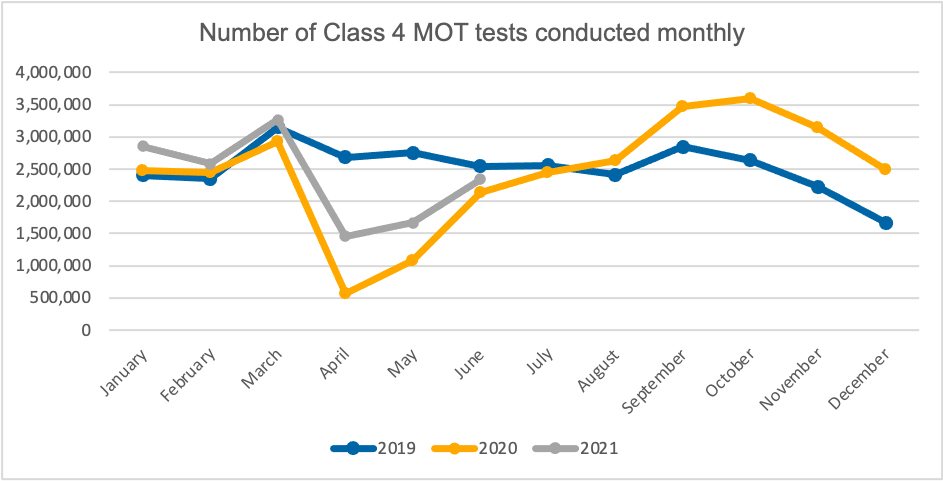MOT test numbers made a strong recovery between April and June of this year, following the disruption caused by last year’s MOT extension, new data from the Driver and Vehicle Standards Agency (DVSA) suggests.
The DVSA data, obtained by BookMyGarage.com through a Freedom of Information (FOI) request, shows 45% more MOTs took place in Q2 2021 than in Q2 2020.
“While MOT test numbers between April and June are still some way off 2019 levels, it’s interesting to see numbers have recovered by almost half, or some 1.7 million tests,” said Karen Rotberg, co-founder of BookMyGarage.com.
“That means approximately half of the 3.4 million additional MOT tests that took place between September and December last year have already been conducted. So, while this autumn and winter will still be busier than normal for garages, we don’t expect it to be quite to the same extent as last year.”
However, test numbers were still down 32% compared to Q2 2019, with Continental Tyres warning drivers to book their MOTs in good time, as more than five million additional tests are due for annual renewal in the second half of 2021.
UK motorists were granted a six-month extension to MOTs which were due between March 30 and July 31, 2020, due to the Covid-19 pandemic.
During this time, 5.3 million less tests took place, compared to the same period in 2019, says Continental.
Drivers began to re-book these postponed tests from September 2020 onwards, creating a huge surge in demand to clear this backlog, on top of tests already due in the winter months.
Now, these MOTs are once again due for their annual review, making September – December 2021 a far busier time to book a test than at other points in the year, it says.
Continental Tyres’ analysis of MOT data from 2018 to 2020 has found that September 2021 will see 23 percent more MOTs booked than usual, with even higher increases predicted for later in the year, with around 42 percent more test bookings anticipated in November 2021, and 51 percent more expected in December 2021.
 Source: BookMyGarage.com
Source: BookMyGarage.com
Tracey Mortimer Continental Tyres’ consumer sales director UK and Ireland believes the coronavirus-led MOT test postponements have now created a new ‘peak’ time for MOTs in the UK, which could take years to rectify.
“Traditionally, there is a fairly consistent demand for MOT testing across the year,” she said. “For example, between 3 and 3.5 million MOTs were conducted each month during 2018 and 2019, with only slight peaks in demand in March and September linked to new car registrations, and a slight dip in tests in December.
“The postponements to millions of MOTs in 2020 has now created a new seasonal demand curve, which is likely to take over 10 years to return to pre-2020 levels.”
Continental’s analysis of MOT data shows that between 800,000 and 1.2 million additional tests are due to take place each month from September to December 2021, with test rates peaking in September and October at around 4.4 – 4.5 million tests a month - significantly higher than the highest peaks in 2018 and 2019.
The Continental analysis of the last three years of new car registrations shows it could take up to 14 years before this curve levels out.
Mortimer explained: “Demand for MOT tests in April and May is now 2 - 2.5 million lower each month than before the pandemic. Because MOTs are only required when a car is three years-old, annual demand for MOTs during these months will only increase by the number of new cars registered in April and May three years prior.
“With typical average monthly car registrations totalling just 185,000 vehicles in April and 215,000 in May it will take many years for the April and May MOT volumes to return to previous levels.
“What’s more, in 2020 there were just 25,000 cars registered in total across the two months which is far lower than pre-pandemic levels, so we expect virtually no change in MOT demand from 2022 to 2023 when these vehicles are due their first MOT.”
Not only will MOT stations and workshops need to ensure they can cope with the increased demand in MOTs and related maintenance work, this new seasonal MOT curve will likewise increase demand for tyres during these busier periods.
Mortimer said: “Tyre replacements are very common at MOT time with 10% of tests failing due to worn tyres, and as garages rectify tyre issues ahead of submission of tests to avoid failure.
“This data shows that things will be very busy for workshops from September onwards, so we advise motorists to plan ahead, to ensure they are able to book a test and to check and replace their tyres early in anticipation of the test to avoid unnecessary delays or indeed, time off the road.”
Continental expects a 23% increase in MOTs due during September 2021 over typical levels, with a 42% increase in November and a 51% increase in December.
It says 608,000 fewer MOTs were taken in 2020 than in 2019, due to some MOTs from July 2020 being completed in January 2021, as well as an increase in the number of vehicles declared as SORN which totalled more than 250,000.





















Login to comment
Comments
No comments have been made yet.